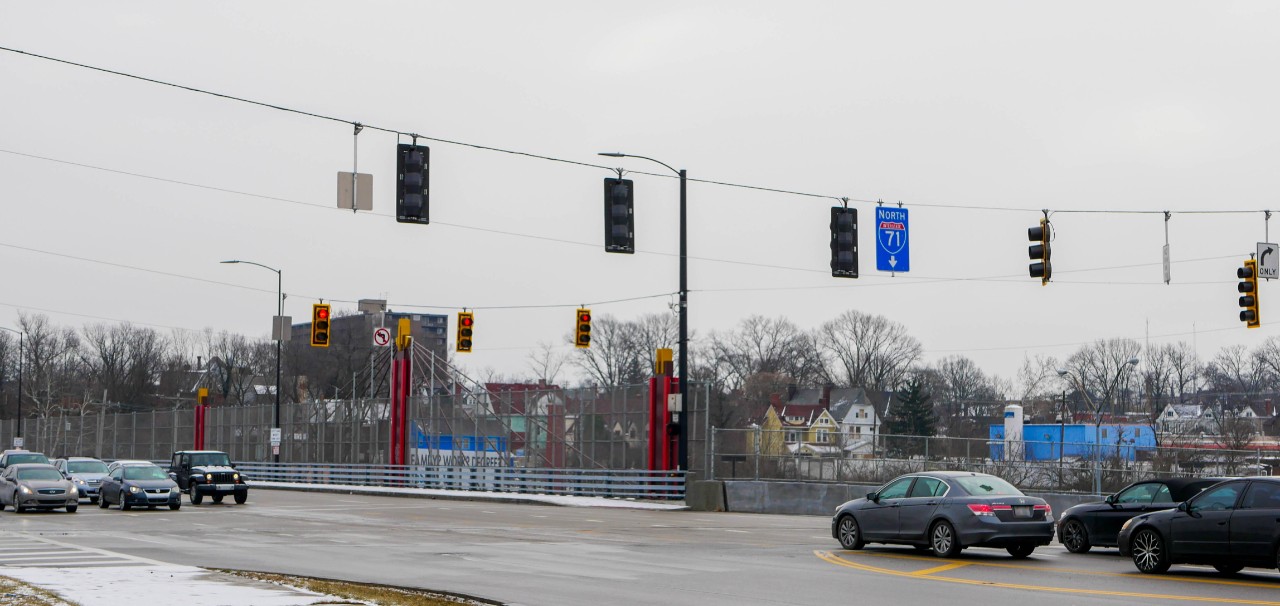
UC students improve traffic flow
By studying traffic signals, a team of UC students presents a plan to reduce traffic congestion

The team used a software tool called ViSim to simulate traffic flow at the intersection of I-71 and Martin Luther King Drive. Graphic/Provided
Like a cup of coffee or our favorite radio station, traffic is a routine part of our daily commute. But students at the University of Cincinnati are trying to change that.
By adjusting the timing of traffic lights at a popular intersection near campus, UC students found they could improve the traffic flow, even during rush hour.
The students completed this semester-long project for UC professor Heng Wei’s traffic engineering course. They presented their findings to the Ohio Department of Transportation and other traffic professionals in the Tristate area.
“Presenting this work can really influence traffic,” said Maggie Loeffler, a civil engineering student on the project. “We hope it leads to more grants for UC to continue studying intersections and proposing traffic solutions.”
The team focused on the corner of I-71 and Martin Luther King Drive, an especially busy intersection and entryway to the university.
The UC team poses with its poster. The team hopes the findings will reduce traffic congestion. Photo/Provided
At this intersection, the City of Cincinnati currently uses a fixed-timing traffic signal system, meaning the light’s timing changes based on the expected traffic throughout the day. The team acquired the city’s traffic plans and signal designs and went to work.
The team first determined if this fixed-timing system worked best, or if a semi-actuated system, one that uses a sensor to trigger traffic lights, would work better. To do this, the students analyzed the city’s signal designs and gathered information on the intersection, like delays, stop times, light timing and the number of vehicles. The team then used this information to create various diagrams and charts.
“Traffic flow is a giant puzzle, and any changes we make has a domino effect,” Loeffler said.

The intersection the team studied is about a mile east of campus. Photo/Corrie Stookey/CEAS Marketing

The UC team found that a fixed timing traffic signal could reduce average delay times an increase average speeds of cars at the intersection. Graphic/Provided
To solve this puzzle, the team plugged all the traffic data into a software tool called ViSim. Based on a minimum delay algorithm and the numbers at hand, Ph.D. candidate Yi Guo, another student on the team, simulated a traffic flow through ViSim to compare the different types of traffic signals.
The team concluded that an adjusted fixed-timing traffic plan would work better than the city’s current plan. The team’s findings showed statistically significant results backing this new traffic plan, which would reduce cars’ average delay time while increasing the average speed.
Future traffic work at UC could incorporate students from all across campus, including designs from students at the College of Design, Art, Architecture and Planning, as well as simulations and models from computer science students.
Red lights may be inevitable, but they shouldn’t be longer than they need to be. With the insights of students at the University of Cincinnati, unnecessary traffic may be left in the rearview.
The following UC students were on the project: Yi-Hsuan Tsai, Maggie Loeffler, Yi Guo, Tao Li and Pengyuan Chen. UC professor Heng Wei advised them.
Featured image at top: The intersection of Martin Luther King Drive and I-71 is popular entryway for drivers coming into campus. Photo/Corrie Stookey/CEAS Marketing
Related Stories
Engineering professors studying how co-op impacts student journey
January 5, 2026
Cedrick Kwuimy, associate professor educator in the Department of Engineering and Computing Education at the University of Cincinnati College of Engineering and Applied Science is studying how a student’s first co-op experience impacts the remainder of their journey as an engineering student, and how educators can better prepare them for these experiences. Kwuimy and his collaborators have received a three-year grant from the National Science Foundation (NSF) to support this research.
Supporters give generously to the Bearcats Pantry and Resource Center
December 22, 2025
Supporters gave generously to the Bearcats Pantry and Resource at the University of Cincinnati during two fundraisers: the Crosstown Foodout and Giving Tuesday.
UC student breaks world record in competitive speedcubing
December 19, 2025
UC computer science student Sujan Feist set a new world record in speedcubing at competition this month in Coshocton, Ohio. Feist is the reigning world champion in the 2x2 division.
